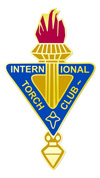
Meeting Minutes
Torch Club of the Fox Valley
13 March 2014
Atlas Coffee Mill & Café
Notes taken by: Jude Kuenn, secretary
Attendees: Jim Baumbach, Nancy Bodway, Al Button, Janet Wullner-Faiss Cloak, Dwight Easty, Neal Gamsky, Jean Jepson, Barbara Kelly, Bill Kelly, Jude Kuenn , Mary Poulson, Richard Schoenbohm, Jan Smith, Bob Swain, Peter Thiel, Donna Weis, David Woods
Guest: Helen Thiel
BUSINESS MEETING
Meeting called to order at 6:40pm
- Guest: Helen Thiel welcomed.
- Minutes from 2/13/14 meeting were accepted, motioned and approved.
- Treasurer’s report: Neal’s refund (joining after January 1), Fox Cities Online remittance, second half membership payment to IATC, left 3/05/14 balance at $1,437.69. ($50 of $70 per person annual dues goes to IATC.) Report accepted, motioned and approved.
- Annual Meeting – Board members in a two-year term, no voting needed this year; date noted.
- Selection of Delegates and Alternate Delegates to the International Torch Club’s Annual Conference, 6/19-22/14 in St. Catherines (Niagara), Ontario, Canada. Richard suggested vote be taken on delegates, then on how to handle $250 reimbursement IATC provides one delegate representing us. Reimbursement dependent upon attending a number of meetings during the conference. Club delegates are: 1) Janet Cloak and 2) Donna Weis; alternate delegates are: 1) Al Button, 2) Barbara Kelly and 3) Bill Kelly. Bill motioned the Club pay registration fee for each delegate (~$330). Motion was accepted and approved. Barbara suggested delegates register and send their check to IATC; the Club will reimburse them. Richard to advise IATC names of Fox Valley Chapter delegates.
- Old Business -
a: Follow-up on District Training Conference - 4/19/14 in Lincoln, NE. Richard asked if anyone was interested in attending the day; the district includes four NE Chapters, Appleton, Boulder and Des Moines Chapters. No one to attend. - New Business -
a: Upcoming important Torch dates – April meeting will have sign-up sheet for next year’s programs. Members can list more than one proposed topic; the 2014-2015 program list will be confirmed at the September meeting. Richard cannot make 5/08/14 meeting, so Bob will chair in May.
b: Other new business: -
Peter – noticed Paul was looking down while presenting in February, suggested a table lectern and will use one for this evening’s presentation. Bill suggested to ‘table the table’, pending feedback from Peter as to whether the Club needs their own lectern.
Richard - IATC questionnaire for summer 2014, reply requested by 4/30/14. Paper will be circulated for the next meeting. - Announcements -
Jan – Bergstrom-Mahler Museum of Glass’ next show after student exhibit will feature Bullseye Glass of Portland, OR. Bullseye’s artists-in-residence will be featured. Show opens 4/12/14 with curator/member opening reception on Monday 4/14/14. Bullseye Glass is an international company with high-end development and experimental glass.
Dwight – asked where we ‘stand’ in using Atlas’ meeting rooms. Other space is being remodeled, addressing sound management. Moving tables in a more pleasing format is an option when meetings exceed 25 and/or need a projector and screen. The larger room had a psychological effect: it seemed more challenging to get folks to sit down.
Sue at Atlas Mill’s 70th birthday was 3/13/14. Everyone sang happy birthday to her, led by Nancy.
Business segment adjourned at 7:17pm for dinner.
- Peter presented Water – Our Most Important Resource.
Water is always in the news and is important to our life: directly and indirectly.
Peter shared some childhood memories of how water inspired youthful dreams and his imagination. ‘Pollution’ was not in his vocabulary when a child, it entered in Peter’s teens.
Water provides transportation, food, power, recreation and handles waste discharge. It is a finite resource: 71% of the Earth’s surface is water, 97.3% of that is not potable, 2.7% is fresh water from mountains, polar ice caps and glaciers, and 0.3% of that is potable. Mankind is a poor steward of this critical resource.
Water is a mineral and can be solid, liquid, mineral and/or gaseous (clouds). There is fresh water and salt water. Here are some fresh water uses in the US -
1) thermoelectrical = 48% water used for cooling
2) irrigation = 35%
3) public supply = 11%
4) industrial = 5%
5) other industries = <3%
Threats to water include -
a) irrigation run-off - from chemically-treated soil
b) food industry – washing, cooling, cooking
c) power industry – warm/hot water discharge
d) paper industry – manufacturing waste of product
e) mining industry – contamination via extracting
f) petro industry – discharging into aquifers
g) steel industry – discharging water used in rolling mills
h) beverage industry – extracting from streams at the expense of fish and the environment, affects the ecology of the area
i) municipal waste treatment – developing countries dump 70% of industrial untreated waste into their water source. Domestically, we have poor storm water systems and outdated waste treatment systems; U.S. example: Detroit
Third world countries lack education and funds, which prevent the development of water sources and sanitary living. United Nations involvement is needed to assist these areas.
There will be a 50% increase of water usage in the next 30 years. We must -
* conserve usage
* seek potable options
* address global warming (by 2100, polar ice melt will raise oceans 3’ to 4’)
* with population growth from 7.2 billion to 10.9 billion by 2050, manage raw sewage
* stop fertilization run-off by considering drip irrigation
* capture rain water
* reforest and follow topographic planting
* develop low-cost method of desalination to create potable water
* create and enforce water regulations
* assist developing countries in smart water use
We must become a good steward of this important resource.